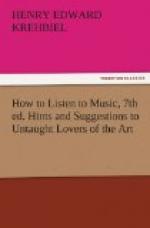The string quartet, it will be seen, makes up nearly three-fourths of a well-balanced orchestra. It is the only choir which has numerous representation of its constituent units. This was not always so, but is the fruit of development in the art of instrumentation which is the newest department in music. Vocal music had reached its highest point before instrumental music made a beginning as an art. The former was the pampered child of the Church, the latter was long an outlaw. As late as the fourteenth and fifteenth centuries instrumentalists were vagabonds in law, like strolling players. They had none of the rights of citizenship; the religious sacraments were denied them; their children were not permitted to inherit property or learn an honourable trade; and after death the property for which they had toiled escheated to the crown. After the instruments had achieved the privilege of artistic utterance, they were for a long time mere slavish imitators of the human voice. Bach treated them with an insight into their possibilities which was far in advance of his time, for which reason he is the most modern composer of the first half of the eighteenth century; but even in Handel’s case the rule was to treat them chiefly as supports for the voices. He multiplied them just as he did the voices in his choruses, consorting a choir of oboes and bassoons, and another of trumpets of almost equal numbers with his violins.
[Sidenote: The modern band.]
The so-called purists in England talk a great deal about restoring Handel’s orchestra in performances of his oratorios, utterly unmindful of the fact that to our ears, accustomed to the myriad-hued orchestra of to-day, the effect would seem opaque, heavy, unbalanced, and without charm were a band of oboes to play in unison with the violins, another of bassoons to double the ’cellos, and half a dozen trumpets to come flaring and crashing into the musical mass at intervals. Gluck in the opera, and Haydn and Mozart in the symphony, first disclosed the charm of the modern orchestra with the wind instruments apportioned to the strings so as to obtain the multitude of tonal tints which we admire to-day. On the lines which they marked out the progress has been exceedingly rapid and far-reaching.
[Sidenote: Capacity of the orchestra.]
[Sidenote: The extremes of range.]
In the hands of the latter-day Romantic composers, and with the help of the instrument-makers, who have marvellously increased the capacity of the wind instruments, and remedied the deficiencies which embarrassed the Classical writers, the orchestra has developed into an instrument such as never entered the mind of the wildest dreamer of the last century. Its range of expression is almost infinite. It can strike like a thunder-bolt, or murmur like a zephyr. Its voices are multitudinous. Its register is coextensive in theory with that of the modern pianoforte,




